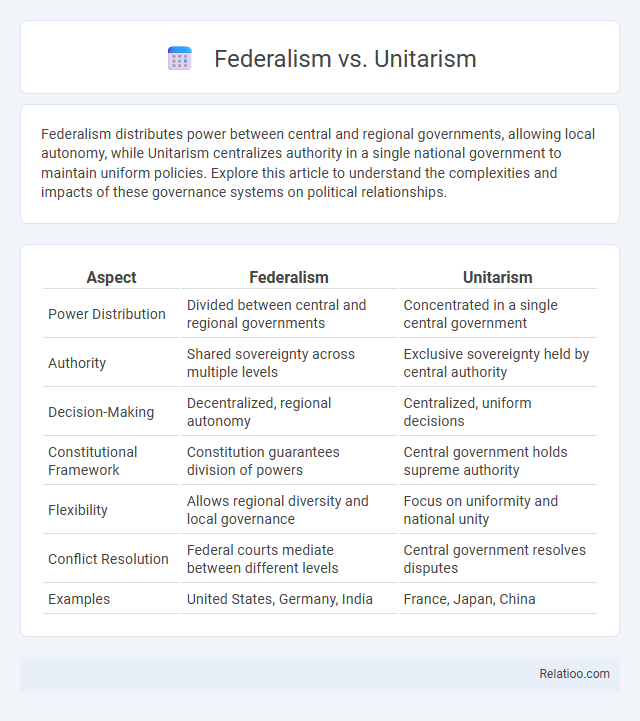Federalism distributes power between central and regional governments, allowing local autonomy, while Unitarism centralizes authority in a single national government to maintain uniform policies. Explore this article to understand the complexities and impacts of these governance systems on political relationships.
Table of Comparison
| Aspect | Federalism | Unitarism |
|---|---|---|
| Power Distribution | Divided between central and regional governments | Concentrated in a single central government |
| Authority | Shared sovereignty across multiple levels | Exclusive sovereignty held by central authority |
| Decision-Making | Decentralized, regional autonomy | Centralized, uniform decisions |
| Constitutional Framework | Constitution guarantees division of powers | Central government holds supreme authority |
| Flexibility | Allows regional diversity and local governance | Focus on uniformity and national unity |
| Conflict Resolution | Federal courts mediate between different levels | Central government resolves disputes |
| Examples | United States, Germany, India | France, Japan, China |
Introduction to Federalism and Unitarism
Federalism is a political system where power is constitutionally divided between a central authority and constituent political units, allowing regional governments to exercise autonomy in certain areas. In contrast, unitarism centralizes authority, granting the national government supreme power over all administrative divisions with limited or no self-governance. Understanding federalism and unitarism is essential for analyzing governance structures and the distribution of political power within a state.
Historical Evolution of Governance Structures
Federalism emerged as a response to the limitations of unitary states, allowing multiple autonomous governments within a single political system, traced back to the Articles of Confederation in 1781 and later refined by the U.S. Constitution in 1787. Unitarism centered on a centralized authority, evident in early nation-states such as France post-French Revolution, emphasizing uniform policies and administrative control. Governance has evolved to incorporate hybrid models balancing central authority with regional autonomy, influenced by globalization and increasing demands for local participation in decision-making processes.
Core Principles of Federalism
Federalism is characterized by the division of power between a central authority and constituent political units, ensuring both levels of government have constitutionally protected autonomy. Unlike unitarism, where power is centralized, federal systems maintain multiple layers of governance that allow local governments to manage their affairs independently. Your understanding of governance improves by recognizing that federalism promotes shared sovereignty, checks and balances, and cooperative policymaking to address diverse regional needs.
Key Features of Unitarism
Unitarism centralizes authority, consolidating decision-making power within a single, national government, ensuring uniform policies across all regions. This system eliminates regional autonomy, simplifying administrative control and reducing the complexity found in federal structures. Your interaction with governance under unitarism involves a streamlined hierarchy where local governments primarily implement decisions made by the central authority.
Power Distribution: Centralization vs Decentralization
Federalism features a decentralized power distribution where sovereignty is constitutionally divided between central and regional governments, allowing local authorities significant autonomy. Unitarism centralizes power within a single governing body, with regional entities operating primarily as administrative arms without independent authority. Governance encompasses the mechanisms and processes through which power is exercised at multiple levels, balancing central control and local autonomy to enhance effectiveness and responsiveness.
Advantages and Disadvantages of Federalism
Federalism allows for decentralized power, enabling regional governments to address local needs effectively and promote political participation, fostering diversity and innovation in policy-making. However, it can lead to inefficiencies, duplication of services, and conflicts between federal and state authorities, complicating governance. Compared to unitarism, federalism supports local autonomy but may weaken national unity, while governance frameworks determine how power and authority are distributed and exercised across different political systems.
Pros and Cons of Unitary Systems
Unitary systems centralize authority within a single national government, streamlining decision-making and ensuring uniform policies across regions, which can enhance national unity and reduce administrative costs. However, this concentration of power may lead to slower responses to local issues, reduced regional autonomy, and potential neglect of diverse community needs. While unitary governance promotes consistency and efficiency, it often struggles with accommodating regional diversity and local participation compared to federal systems.
Case Studies: Countries Practicing Federalism
Countries practicing federalism, such as the United States, Germany, and India, demonstrate diverse approaches to balancing power between central and regional governments. Your understanding of federalism deepens by examining how these nations allocate legislative authority, fiscal responsibilities, and political autonomy to states or provinces. Case studies reveal federalism's role in accommodating ethnic diversity, enhancing policy innovation, and managing regional inequalities compared to unitary states that centralize governance.
Case Studies: Unitary States in Practice
Unitary states such as France, Japan, and the United Kingdom demonstrate how central governments maintain primary authority, streamlining decision-making and policy implementation across the nation. These case studies reveal You benefit from uniform legal frameworks and consistent public services, as regional administrations hold limited autonomy. Comparing unitary frameworks with federal systems highlights the balance between centralized control and administrative efficiency in governance models.
Choosing the Right System: Factors and Considerations
Choosing the right system between federalism, unitarism, and varied governance models depends on factors like population diversity, geographic size, and the need for local autonomy versus centralized control. Federalism suits countries with multiple ethnic groups or regions requiring self-governance, while unitarism benefits smaller or more homogeneous nations by ensuring uniform policy implementation. Governance effectiveness hinges on balancing political stability, administrative efficiency, and citizen participation within the chosen system.

Infographic: Federalism vs Unitarism
 relatioo.com
relatioo.com